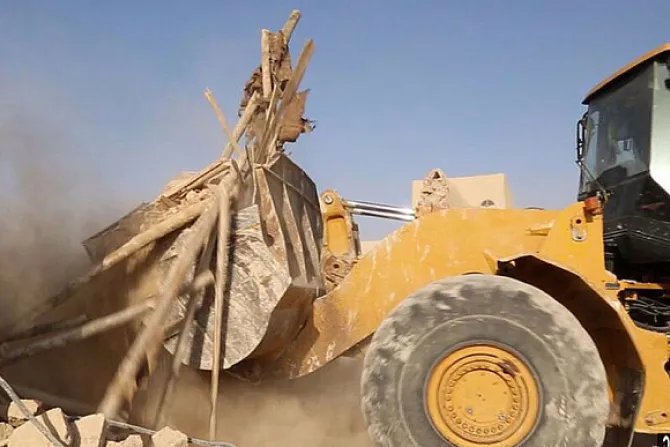Homs, Syria, Aug 21, 2015 / 14:10 pm
Reports surfaced on Thursday that Islamic State militants have bulldozed Mar Elian Monastery, an ancient structure located just outside a Syrian town captured by the group earlier this month.
The Syrian Observatory for Human Rights, a British-based monitoring group, on Aug. 20 said that the Islamic State had destroyed the monastery using bulldozers. Photos of the destruction were soon released online by the militant Sunni Islamist group.
The destruction was confirmed to the AP by a priest in Damascus.
Mar Elian monastery, which was founded before the year 500, is located just outside Al Quaryatayn, which is some 60 miles southeast of Homs. The monastery also provided refuge to hundreds of Syrians displaced from Al Quaryatayn, and partnered with Muslim donors to provide for their needs.
The town was captured by the Islamic State Aug. 6, and between 160 and 230 Christians and Muslims were abducted from the town.
Many of the Christians who were in Al Quaryatayn when it fell to the Islamic State had fled there from Aleppo. Around 30 Christians were able to escape the town for Homs after it was captured.
According to the Syrian Observatory for Human Rights, Islamic State has transported 110 of the captives from Al Quaryatayn to its de facto capital, Ar Raqqah.
In May, two members of Mar Elian's community had been abducted: Father Jacques Mourad and Deacon Boutros Hanna. Fr. Mourad was prior of Mar Elian, and was pastor of a parish in Al Quaryatayn, where he served as an active mediator between the Syrian army and rebel forces.
The Islamic State has persecuted all non-Sunni persons in its territory – Christians, Yazidis, and even Shia Muslims. It destroys any non-Sunni religious sites, which are regarded as pagan. In addition to churches, it has destroyed Shia mosques and shrines, and the sites of ancient, pre-Islamic cities.
The militant group overran the ancient city of Palmyra in May, and have since destroyed statues and other artefacts there. It was reported Aug. 19 that Islamic State militants had killed Khaled al-Asaad, an 81-year-old archaeologist who curated the ruins at Palmyra.
Since the Syrian civil war broke out in March 2011, more than 230,000 people have been killed. Four million have become refugees, and another 8 million have been internally displaced.
What began as demonstrations against the nation's Ba'athist president, Bashar al-Assad, has become a complex fight among the Syrian regime; moderate rebels; Kurds; and Islamists, such as al-Nusra Front and the Islamic State.


